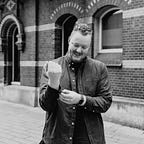Language that doesn’t appeal to everyone, is that possible?!
This blog was posted earlier on rauwcc.nl
Language is a beautiful thing. It ensures that we understand each other and can express ourselves. But something strange is going on. Our language, Dutch, is losing the most important function I think it has. It no longer appeals to people. What now? Is Dutch now hopelessly outdated? Do we have to invent a new language or can Dutch still be saved? Before you start typing in the comments that there is nothing wrong with Dutch. Quiet. Basket. That’s not what I write either. There is certainly nothing wrong with Dutch, but it could be better. And it is not only possible, but it must also be. And soon.
And this is why. More and more people are expressing how they feel and want to be. The largest group of these are the Gen-Zs (I am one myself). We break with the norms and values surrounding gender and sexuality. They are old-fashioned and out of date. And since we, the “TikTok generation,” are now at the point where we graduate and start our careers, it’s time to change things up a bit. Because why should our language be more inclusive? As I wrote, the male and female categories are hopelessly outdated and old-fashioned. You are just who you want to be. Male, female, non-binary, transgender, or gender fluid. Who cares? But why should we still address each other as he/him or she/her? And why are there still carpenters (timmermannen) and lice mothers (luizenmoeders)? Fuck that!
Let’s start with the carpenters. Timmerman, as it is called in Dutch specifically mentions a man. Can’t a woman be a carpenter?! Of course, she can! Instead of a timmerman, you can also say woodworker (houtbewerker). And I hear you think, that’s already happening anyway. Take primary school, for example. Most primary schools no longer talk about boys and girls, but about children. And those children have parents, not fathers and mothers. We no longer find that strange or special, but very normal. More and more professions are also inclusive. Where in the past people were looking for secretaries (secretaressen), they are now looking for administrative employees (administratief medewerkers). NS service announcements have also become more inclusive and gender-neutral. Today, not only ladies and gentlemen hear that the train is delayed, but all travelers. There was quite a bit of commotion when NS did this, but four years later it has become perfectly normal.
Inclusive language use is therefore quite easy. But, assume adding he/she is enough. And if you start writing words as medewerk(st)er (a mix of a male and female employee) or hij (a mix of he and she), you lost the game. Fortunately, Mevrouw Alfabet has some useful tips:
- Speak to someone directly. Are you writing a text that you want to directly address the reader? Just use you and you. You speak to someone directly. Whoops! Would you rather be a bit neater? Then use you.
- Use neutral words as much as possible, such as resident, person, or people. This works great for a carpenter. He is now a woodworker.
- Avoid stereotypes. Not every woman wants children. Not every gay man likes fashion. They are dangerous and you use them faster than you think. But try to pay attention to it.
Now that you know how to write more inclusively, I’ll take you to the other hot topic: gender-neutral language. Yes! What is that? Gender-neutral language is mainly about how you address a person. And that goes beyond just him or her. In Dutch there are three official pronouns. He/him (hij/hem), she/her (zij/haar), and them/their (hen/hun). Hen/hun? Yes. You use that when someone does not identify as a man or woman. A non-binary person. But you have more names for non-binary persons. Some people use that/them (die/diens). But how do you use it? Just ask how someone would like to be addressed. Now you immediately know how to address someone and at the same time, you show that you are an ‘ally’. It will certainly take some getting used to and you will certainly make a mistake once. That’s part of the deal. If we don’t start now, it stays with trial and error.
In short, inclusive and gender-neutral language is not that difficult at all. It’s just a matter of doing. And when should we do it? It should’ve been done yesterday. We live in 2021 and we no longer have to think in black and white. We must think in the color of our hearts. It’s time to push forward. It is time for the old-fashioned pigeonholes to be a thing of the past when it comes to language. And luckily you can make the change. Language is flexible and it moves with the times. Now it’s up to us to move with it.
